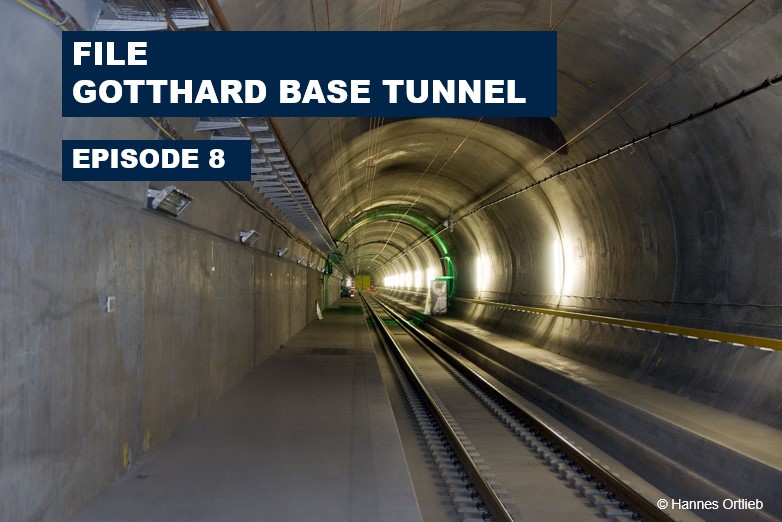The Swiss Safety Investigation Authority (Sust) names a broken wheel disc as the cause of the freight train accident in the Gotthard Base Tunnel. In the news report from 19 October 2023, Swiss television SRF took a close look at the maintenance of freight wagon wheels. VAP expert Jürg Lütscher comments on the safety and control tasks of the players involved – and explains them further in this blog post.
This is what it’s all about:
- Harmonised safety in the European rail freight system
- Maintenance work monitored by independent bodies
- Wheelset inspections in operation and maintenance
- Two inspection procedures established
- Responsibilities and regulations clarified
Harmonised safety in the European rail freight system
Safety in the European rail freight system is based on a triangle of responsibility consisting of infrastructure managers, railway undertakings (RUs) and wagon keepers with their responsible entities in charge of maintenance (ECMs). The specifications and regulations are now largely harmonised throughout Europe. The industry has developed the internationally recognised VPI European Maintenance Guide (VPI-EMG) based on the provisions of the sovereign directives, the applicable technical standards and practical experience. The VPI Germany, VPI Austria and VAP (Switzerland) associations have been pioneering this work since 2007. In 2019, AFWP (France) and UIP (International Union of Wagon Keepers, representing the smaller national associations) were added to the group of editors of the VPI-EMG. This set of rules defines both deadlines and the scope of work and standards in a user-friendly manner. It provides maintenance recommendations that each user must check for applicability to their freight wagons, supplement if necessary and approve for their wagon fleet. More than 550 companies, including wagon keepers, ECMs, repair workshops, authorities and universities, currently use the VPI-EMG. More than 260 repair workshops and mobile service teams from 19 European countries use the VPI-EMG on behalf of the relevant ECM.
Maintenance work monitored by independent bodies
The EU safety directive defines two independent procedures. This is to ensure that the specialised work is carried out everywhere with the required level of quality and knowledge:
- Certification: The companies involved must be certified by independent bodies for security-related activities within the scope of their ECM. They must regularly renew these certificates and allow their customers to view their validity and scope.
- Auditing: Supervisory authorities carry out risk-based audits of safety-critical processes and quality inspections in railway operations. If they uncover weaknesses, they also monitor their rectification.
Wheelset inspections in operation and maintenance
Wheelsets are considered safety-critical components of a rail vehicle. They are subject to continuous wear during operation and can also be damaged by external influences. When maintaining wagons, the ECM ensures that fully functional wheelsets are used.
During operation, the RUs and the train control systems of the infrastructure managers (see blog post «Gotthard Base Tunnel (#2): Automatic train control systems») specifically ensure that no recognisable damage or deviations on wagons jeopardise operational safety. To ensure safe railway operations, the wheelsets must comply with all relevant limit values during the entire operating time. Wheelsets that have been replaced due to deviations or damage are sent to a certified specialist workshop for reconditioning in accordance with the regulations.
Two test procedures established
The SRF news report shows two test procedures for systematic wheelset maintenance. A certified specialist workshop can thus ensure that the wheelsets it repairs do not show any relevant damage in the form of material cracks on delivery. This involves two non-destructive testing methods in accordance with DIN 27201–7, which have become established throughout the industry:
- Ultrasonic testing: Detection of cracks in the wheel face and flange back area
- Magnetic testing: Detection of cracks in the wheel centre and wheelset shaft including wheel seat
Responsibilities and regulations clarified
As many goods are transported across borders, internationally harmonised rules and procedures are important in Europe. In recent years, the regulations have been comprehensively updated and improved. Current versions of the EU Safety and Interoperability Directive apply both in all EU states and – via the overland transport agreement – to the Swiss standard gauge network. Based on this, the Swiss railway sector has developed practical standards and maintenance procedures for the main players. Europe-wide common reporting processes and assessment procedures (see blog post «Gotthard Base Tunnel (#7): Sust report provides clarity») ensure that industry players learn their lessons from an operational incident such as that of 10 August 2023 and implement effective improvements in maintenance.



